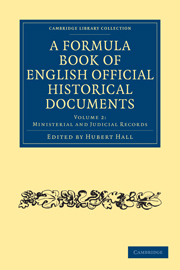A - ROYAL SURVEYS, INQUISITIONS AND ASSESSMENTS
Published online by Cambridge University Press: 07 September 2010
Summary
The very miscellaneous collection of official documents that have been grouped for the purpose of diplomatic study under the above heading will be found to follow, more or less closely, a general plan of official procedure. In the first place, we should expect to find an ‘originating writ’ in the shape of a royal precept, but this is often wanting in early documents or is replaced by a historical narrative or by an official heading. In some cases, such as inquisitions ex officio and judicial presentments, the Return is made without a special precept. Secondly, there should be found, as an Appendix or schedule to the Writ, certain directions for the enquiry which in later times were given in the shape of ‘Articles’ or ‘Chapters’ (No. 57), but which may be compendiously expressed in a Forma Inquisitionis (No. 15 (b)) or recited in a mere preamble (No. 19). In other cases, however, these instructions are given seriatim in the Writ itself (No. 41). This should also contain a direction as to the date and place of delivery of the Return, and a memorandum of execution was in later times more frequently endorsed upon the Writ by the returning officer with a description of the form and extent of the accompanying Return ‘in the Schedule’ (No. 27).
This Return, the third feature of an Inquisition, represents the verdict, recognition, or presentment of the Jurors whose names should form part of the ‘Record.’ Naturally the latter was of varying aspect and bulk, and it is known by various titles according to the subject of the Writ.
- Type
- Chapter
- Information
- Publisher: Cambridge University PressPrint publication year: 2010First published in: 1909



